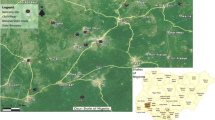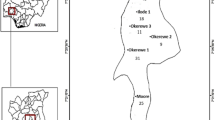Abstract
Diarrhoea remains a global public health enigma raising deep concerns for the health planners since contaminated potable water often spoils the community health structure. We hereby report a 6-year odd continuing outbreak surveillance report based on potable water indices, during which 264 water samples were screened from different districts of West Bengal, India. Samples were analysed for the presence of different enteropathogenic bacterial species by conventional molecular tools and their sensitivity to antibiotics. 78.03% samples were positive for enteropathogenic bacterial organisms and 75% samples harbored Coliform. 45.45, 12.12, and 4.16% samples were positive for E.coli, V. cholerae, and V. mimicus, respectively. Diarrhoeagenic E.coli 7 EPEC, 10 ETEC, and 2 EIEC were isolated along with 2 V. cholerae O1 Ogawa (ctxA and tcpA ElTor positive), one each from tube well and pond. Interestingly, 4 V.cholerae non-O1/non-O139 also harbored hlyA gene. The detection of toxin genes among this bacterial pool of sampled water indicates the fallout of the potable water sources, thus enabling us to establish that it is none other than the contaminated potable water system which often wreaks havoc in the south Bengal diarrhoeal menace. The consequences are further complicated by the presence of drug-resistant pathogenic bacterial pool to fluoroquinolone, beta-lactams, and cephalosporins, in the accessible potable water, with threats of outbreaks exploding into an epidemic, given suitable environment, poor sanitation, and unhygienic practices. Therefore, we strongly recommend re-modelling of ‘point-of-use water disinfection’ measures and adequate personal hygiene for healthier community life.


Similar content being viewed by others
References
Annual Report, ICMR-NICED. (2013–2014). Indian Council of Medical ResearchAvailable: http://www.niced.org.in/publications/AnnualReports/NICED-AR2013-2014.pdf 30).
In, A. P. H. A. (1995). Eaton, A.D., Clesceri, L.S., Greenberg, A.E., editors. Standard methods for the examination of water, wastewater. 19th ed. Washington, DC: American Public Heath Association.
APHA. (2005). Standard methods for the examination of water and wastewater (21st ed.). Washington, DC: American Public Health Association (APHA), American Water Works Association (AWWA) & Water Environment Federation (WEF).
Batabyal, P., Mookerjee, S., & Palit, A. (2012). Occurrence of toxigenic Vibrio cholerae in accessible water sources of cholera endemic foci in India. Japanese Journal of Infectious Diseases, 65(4), 358–360. https://doi.org/10.7883/yoken.65.358.
Batabyal, P., Mookerjee, S., Sur, D., & Palit, A. (2013). Diarrheagenic Escherichia coli in potable water sources of West Bengal, India. ActaTropica, 127, 153–157.
Batabyal, P., Einsporn, M. H., Mookerjee, S., Palit, A., Neogi, S. B., Nair, G. B., & Lara, R. J. (2014a). Influence of hydrologic and anthropogenic factors on the abundance variability of enteropathogens in the Ganges estuary, a cholera endemic region. Science of the Total Environment, 472, 154–161. https://doi.org/10.1016/j.scitotenv.2013.10.093.
Batabyal, P., Mookerjee, S., Einsporn, M. H., Lara, R. J., & Palit, A. (2014b). High prevalence of toxin producing enteropathogenic Vibrios among estuarine crab in Ganges delta of West Bengal, India. Infection Genetics & Evolution, 26, 359–361. https://doi.org/10.1016/j.meegid.2014.06.001.
Bauer, A. W., Kirby, W. M., Sherris, J. C., & Turck, M. (1966). Antibiotic susceptibility testing by a standardized single disk method. American Journal of Clinical Pathology, 45(4), 493–496.
BIS. (2012). Indian standard drinking Water specification. Bureau of Indian Standards. http://cgwb.gov.in/Documents/WQ-standards.pdf.
Carroll, P. A., Tashima, K. T., Rogers, M. B., DiRita, V. J., & Calderwood, S. B. (1997). Phase variation in tcpH modulates expression of the ToxR regulon in V. cholerae. Molecular Microbiology, 25(6), 1099–1111. https://doi.org/10.1046/j.1365-2958.1997.5371901.x.
Chatterjee, S., Ghosh, K., Raychoudhuri, A., Chowdhury, G., Bhattacharya, M. K., Mukhopadhyay, A. K., Ramamurthy, T., Bhattacharya, S. K., Klose, K. E., & Nandy, R. K. (2009). Incidence, virulence factors and clonality among clinical strains of non-O1, non-O139 Vibrio cholerae isolates from hospitalized diarrheal patients in Kolkata, India. Journal of Clinical Microbiology, 47(4), 1087–1095. https://doi.org/10.1128/JCM.02026-08.
Clinical and Laboratory Standards Institute. (2009). Approved standard M2-A10. Performance standards for antimicrobial disk susceptibility tests (10th ed.). Wayne: CLSI.
Clinical and Laboratory Standards Institute. (2011). M100-S21 (M2). Disk diffusion supplemental tables. Wayne: CLSI.
Costa, R. A., Silva, G. C., Peixoto, J. R., Vieira, G. H., & Vieira, R. H. (2010). Quantification and distribution of vibrio species in water from an estuary in Ceará-Brazil impacted by shrimp farming. Brazilian Journal of Oceanography, 58(3), 183–188. https://doi.org/10.1590/S1679-87592010000300001.
Halder, M., Mookerjee, S., Batabyal, P., & Palit, A. (2017). Environmental Vibrio cholerae non O1/non O139 from the Gangetic delta: a diarrhoeal disease purview. International Journal of Environmental Health Research, 1–11. https://doi.org/10.1080/09603123.2017.1332346
Hoshino, K., Yamasaki, S., Mukhopadhyay, A. K., Chakraborty, S., Basu, A., Bhattacharya, S. K., Nair, G. B., Shimada, T., & Takeda, Y. (1998). Development and evaluation of a multiplex PCR assay for rapid detection of toxigenic Vibrio cholerae O1 and O139. FEMS Immunology & Medical Microbiology, 20(3), 201–207. https://doi.org/10.1111/j.1574-695X.1998.tb01128.x.
Huq, A., West, P. A., Small, E. B., Huq, M. I., & Colwell, R. R. (1984). Influence of water temperature, salinity, and pH on survival and growth of toxigenic Vibrio cholerae serovar 01 associated with live copepods in laboratory microcosms. Applied and Environmental Microbiology, 48(2), 420–424.
Keasler, S. P., & Hall, R. H. (1993). Detecting and biotyping Vibrio cholerae O1 with multiplex polymerase chain reaction. Lancet, 341(8861), 1661. https://doi.org/10.1016/0140-6736(93)90792-F.
Mala, E., Oberoi, A., & Alexander, V. S. (2014). Vibrio isolates from cases of acute diarrhea and their antimicrobial susceptibility pattern in a tertiary care hospital. International Journal of Basic and Applied Sciences, 3(1), 35–37.
Mallin, M. A., Johnson, V. L., & Ensign, S. H. (2009). Comparative impacts of stormwater runoff on water quality of an urban, a suburban, and a rural stream. Environmental Monitoring and Assessment, 159(1), 475–491. https://doi.org/10.1007/s10661-008-0644-4.
Mandal, S. (2011). Cholera epidemic in and around Kolkata, India: endemicity and management. Oman Medical Journal, 26(4), 288–289. https://doi.org/10.5001/omj.2011.71.
McArthur, J. V., Fletcher, D. E., Tuckfield, R. C., & Baker-Austin, C. (2016). Patterns of multi-antibiotic-resistant Escherichia coli from streams with no history of antimicrobial inputs. Microbial Ecology, 72(4), 840–850. https://doi.org/10.1007/s00248-015-0678-4.
Mookerjee, S., Batabyal, P., Halder, M., & Palit, A. (2014a). Specificity of coliphages in evaluating marker efficacy: a new insight for water quality indicators. Journal of Virological Methods., 208, 115–118. https://doi.org/10.1016/j.jviromet.2014.07.036.
Mookerjee, S., Jaiswal, A., Batabyal, P., Einsporn, M. H., Lara, R. J., Sarkar, B., Neogi, S. B., & Palit, A. (2014b). Seasonal dynamics of Vibrio cholerae and its phages in riverine ecosystem of Gangetic West Bengal: cholera paradigm. Environmental Monitoring & Assessment, 186(10), 6241–6250. https://doi.org/10.1007/s10661-014-3851-1.
Mookerjee, S., Batabyal, P., Sarkar, M. H., & Palit, A. (2015). Seasonal prevalence of enteropathogenic Vibrio and their phages in the riverine estuarine ecosystem of South Bengal. PLoS One, 10(9), e0137338. https://doi.org/10.1371/journal.pone.0137338.
Nair, G. B., Ramamurthy, T., Bhattacharya, M. K., Krishnan, T., Ganguly, S., Saha, D. R., et al. (2010). Emerging trends in the etiology of enteric pathogens as evidenced from an active surveillance of hospitalized diarrhoeal patients in Kolkata, India. Gut Pathogens, 2(1), 1.
Ngwa, M. C., Liang, S., Kracalik, I. T., Morris, L., Blackburn, J. K., Mbam, L. M., Ba Pouth, S. F. B., Teboh, A., Yang, Y., Arabi, M., Sugimoto, J. D., & Morris, J. G. (2016). Cholera in Cameroon, 2000-2012: spatial and temporal analysis at the operational (Health District) and sub climate levels. PLoS Neglected Tropical Diseases, 10(11), e0005105. https://doi.org/10.1371/journal.pntd.0005105.
Nhung, P. H., Ohkusu, K., Miyasaka, J., Suna, S. X., & Ezaki, T. (2007). Rapid and specific identification of 5 human pathogenic Vibrio species by multiplex polymerase chain reaction targeted to dnaJ gene. Diagnostic Microbiology of Infectious Diseases, 59(3), 271–275. https://doi.org/10.1016/j.diagmicrobio.2007.05.016.
Palit, A., & Batabyal, P. (2010). Toxigenic Vibrio cholerae from environmental sources associated with the cholera outbreak after ‘AILA’ cyclone in West Bengal. India. Letters in Applied Microbiology, 51(2), 241–243. https://doi.org/10.1111/j.1472-765X.2010.02873.x.
Palit, A., Batabyal, P., Kanungo, S., & Sur, D. (2012). In-house contamination of potable water in urban slum of Kolkata, India: a possible transmission route of diarrhea. Water Science Technology, 66(2), 299–303. https://doi.org/10.2166/wst.2012.177.
Sur, D., Sarkar, B. L., Manna, B., Deen, J., Datta, S., Niyogi, S. K., Ghosh, A. N., Deb, A., Kanungo, S., Palit, A., & Bhattacharya, S. K. (2006). Epidemiological, microbiological & electron microscopic study of a cholera outbreak in a Kolkata slum community. Indian Journal of Medical Research, 123(1), 31–36.
Toma, C., Lu, Y., Higa, N., Nakasone, N., Chinen, I., Baschkier, A., Rivas, M., & Iwanaga, M. (2003). Multiplex PCR assay for identification of human diarrheagenic Escherichia coli. Journal of Clinical Microbiology, 41(6), 2669–2671. https://doi.org/10.1128/JCM.41.6.2669-2671.2003.
Wu, X. J., Pan, J. L., Liu, X. L., Tan, J., Li, D. T., & Yang, H. (2009). Sulfate-reducing bacteria in leachatepolluted aquifers along the shore of the East China Sea. Canadian Journal of Microbiology, 55(7), 818–828.
Funding
Madhumanti Halder (SRF) was financially supported by fellowships from UGC, Govt. of India. Subham Mookerjee (SRF) was financially supported by fellowships from CSIR, Govt. of India (File No. 09/482(0062)/2015-EMR-I).
Author information
Authors and Affiliations
Corresponding author
Rights and permissions
About this article
Cite this article
Halder, M., Mookerjee, S., Batabyal, P. et al. Waterborne outbreaks in diarrhoea endemic foci of India: a longitudinal exploration and its implications. Environ Monit Assess 190, 172 (2018). https://doi.org/10.1007/s10661-017-6424-2
Received:
Accepted:
Published:
DOI: https://doi.org/10.1007/s10661-017-6424-2




